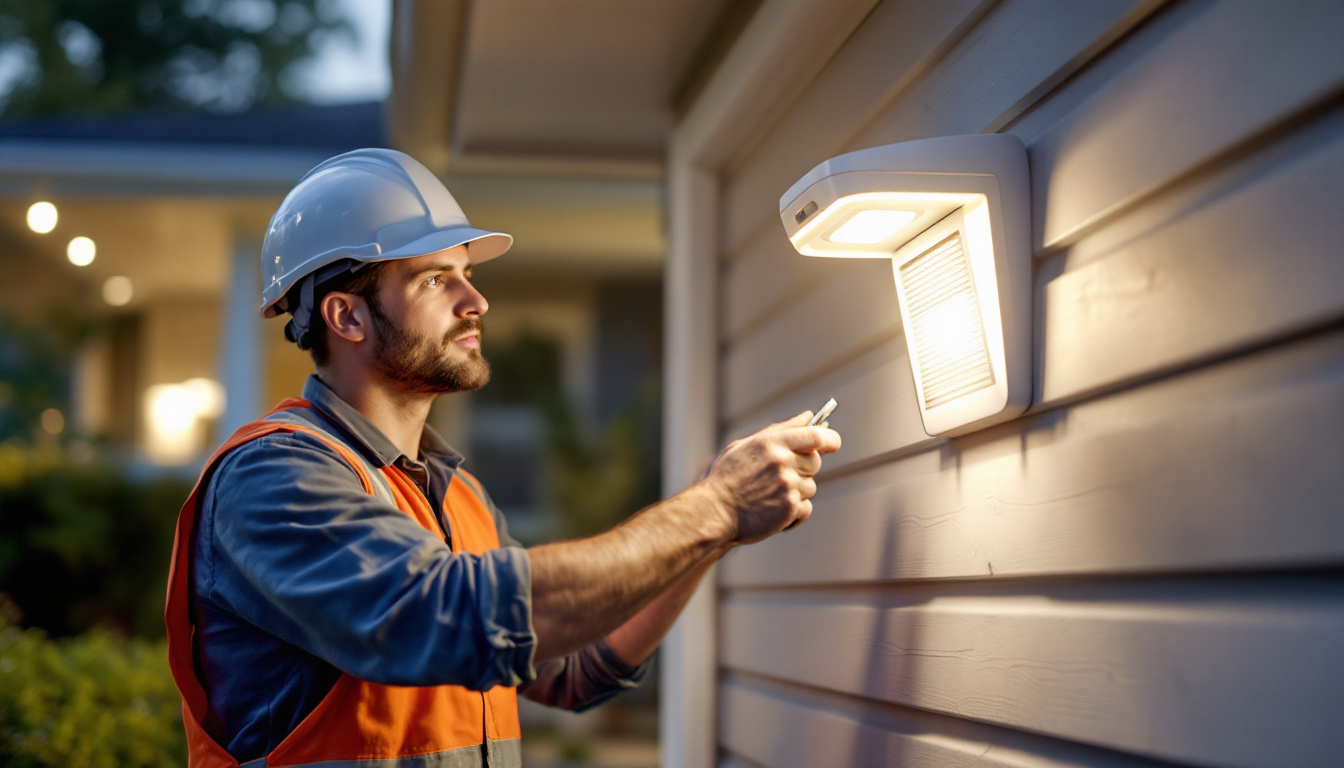
Motion detection lights are an essential component of modern lighting solutions, providing both security and convenience. For lighting contractors, understanding the intricacies of these systems is crucial for delivering effective installations that meet client expectations. This guide will delve into common mistakes made during the installation and setup of motion detection lights, helping contractors enhance their services and avoid potential pitfalls.
Motion detection lights are designed to activate automatically when they sense movement within a designated area. These lights utilize various technologies, including passive infrared sensors, microwave sensors, and dual-technology sensors, to detect motion. They are commonly used in residential, commercial, and industrial settings to enhance security and energy efficiency. The choice of sensor technology can significantly affect the performance and reliability of the system, making it imperative for contractors to understand the nuances of each type. For instance, passive infrared sensors are ideal for detecting heat emitted by moving objects, making them suitable for outdoor applications, while microwave sensors can cover larger areas and penetrate obstacles, making them effective in complex environments.
Incorporating motion detection lighting into a project offers numerous advantages. Firstly, they provide an added layer of security by illuminating areas when movement is detected, which can deter potential intruders. Secondly, they contribute to energy savings, as lights only operate when needed, reducing unnecessary energy consumption. Lastly, they enhance convenience, allowing users to navigate spaces without fumbling for switches. Additionally, these systems can be integrated with smart home technology, allowing users to control lighting remotely through smartphones or voice-activated devices. This integration not only improves user experience but also allows for customized settings, such as adjusting sensitivity levels or scheduling light activation based on personal routines. Furthermore, the installation of motion detection lights can increase property value, as prospective buyers often view energy-efficient and secure homes as more desirable.
While motion detection lights can greatly improve a space, improper installation can lead to inefficiencies and dissatisfaction. Below are some common mistakes that lighting contractors should avoid to ensure successful installations.
One of the most critical aspects of installing motion detection lights is sensor placement. Sensors should be positioned to cover the intended area effectively. Placing them too high or too low can lead to missed detections or unnecessary activations. It is essential to consider the range and sensitivity of the sensor, as well as potential obstructions that could interfere with its operation.
For example, if a sensor is installed near a tree or shrub, it may trigger unnecessarily due to animal movement. Conversely, a sensor placed too far from the area it is meant to illuminate may not detect movement at all. Proper placement involves a thorough assessment of the environment and an understanding of the sensor’s specifications. Additionally, contractors should take into account the angle of the sensor; a slight tilt can significantly alter the detection zone, potentially leaving blind spots that compromise security. Therefore, utilizing a laser rangefinder during installation can provide precise measurements and assist in achieving optimal sensor positioning.
Environmental factors play a significant role in the effectiveness of motion detection lights. Weather conditions, temperature changes, and even the presence of reflective surfaces can affect sensor performance. Contractors should consider these elements during installation to avoid malfunctioning systems.
For instance, extreme temperatures can impact the sensitivity of some sensors, leading to false alarms or missed detections. Additionally, reflective surfaces such as windows can confuse sensors, causing them to activate when no actual movement occurs. Understanding the local environment and selecting appropriate sensors can mitigate these issues. Furthermore, it’s advisable to conduct a seasonal assessment of the installation site, as foliage may change with the seasons, altering the effectiveness of the sensors. In winter, for example, snow accumulation can obscure sensors, while summer growth may create new obstacles that were not present during the initial installation.
After installation, it is crucial to test the motion detection system thoroughly. Many contractors overlook this step, assuming that the installation was successful based on initial observations. However, testing the system under various conditions is essential to ensure it functions as intended.
Testing should include walking through the detection zone at different times of day and in various weather conditions. This process helps identify any issues with sensor placement, sensitivity, or environmental interference that may not have been apparent during initial installation. Moreover, it is beneficial to involve the end-user during this testing phase, as they can provide insights into the system’s performance from their perspective. Gathering feedback on the system’s responsiveness and any false alarms can guide necessary adjustments, ensuring the installation meets the user’s expectations and enhances their safety and convenience.
Selecting the appropriate motion detection lights and sensors is vital for successful installations. Contractors must be aware of the different types of equipment available and how each option fits specific project needs.
There are several types of motion sensors available, each with its advantages and disadvantages. Passive infrared (PIR) sensors are popular for their reliability and cost-effectiveness. They detect body heat and are ideal for indoor applications. However, they may not perform well in outdoor settings where temperature fluctuations are common.
Microwave sensors, on the other hand, emit microwave pulses and can detect movement through obstacles, making them suitable for outdoor use. However, they can be more expensive and may pick up unwanted motion, such as moving branches. Understanding the specific needs of a project will help contractors choose the right type of sensor.
The quality of motion detection lights and sensors can vary significantly between manufacturers. It is essential for contractors to invest in reliable products that come with warranties and positive reviews. Low-quality equipment may save money upfront but can lead to higher costs in the long run due to maintenance and replacements.
Contractors should research manufacturers and consider factors such as durability, warranty, and customer service. Investing in quality equipment not only enhances the performance of the lighting system but also builds trust with clients.
When integrating motion detection lights into existing lighting systems, compatibility is key. Contractors should ensure that the new equipment can work seamlessly with the current infrastructure. This may involve checking voltage requirements, wiring compatibility, and control systems.
Failure to consider compatibility can lead to system malfunctions or the need for costly modifications. A thorough assessment of the existing setup will help contractors avoid these issues and provide a smoother installation process.
Once motion detection lights are installed, adjusting their settings is crucial for optimal performance. Many systems come with adjustable sensitivity, time delay, and range settings that can be fine-tuned to suit specific environments.
Adjusting the sensitivity of motion sensors is essential to prevent false alarms and ensure reliable operation. If the sensitivity is set too high, the lights may activate unnecessarily due to small movements, such as passing animals or swaying branches. Conversely, if set too low, the system may fail to detect legitimate movement.
Contractors should educate clients on how to adjust these settings based on their specific needs and environment. Regular maintenance checks can also help ensure that sensitivity settings remain appropriate over time.
Time delay settings determine how long the lights remain on after detecting motion. Finding the right balance is crucial; too short a delay may result in lights turning off before a person has exited the area, while too long a delay can waste energy. Contractors should recommend settings based on the typical usage patterns of the space.
For example, in a residential garage, a longer time delay may be appropriate to allow homeowners time to enter and exit their vehicles. In contrast, a commercial setting may require shorter delays to conserve energy.
The detection range of motion sensors can often be adjusted to suit the specific layout of a space. Contractors should assess the area and adjust the range accordingly to ensure optimal coverage without unnecessary activations. This may involve a combination of testing and client input to find the most effective settings.
Education plays a vital role in the successful implementation of motion detection lighting systems. Lighting contractors should take the time to inform clients about how these systems work and how to maintain them effectively.
Providing clients with user manuals or guides can help them understand the features and settings of their motion detection lights. This documentation should include information on adjusting sensitivity, time delays, and troubleshooting common issues. A well-informed client is more likely to be satisfied with their lighting system and less likely to encounter problems.
Regular maintenance is essential for ensuring the longevity and effectiveness of motion detection lights. Contractors should offer clients tips on how to maintain their systems, such as cleaning sensors, checking for obstructions, and testing functionality periodically. This proactive approach can prevent issues before they arise and enhance client satisfaction.
Encouraging clients to provide feedback on their motion detection lighting systems can be invaluable for contractors. This feedback can help identify areas for improvement and inform future installations. Additionally, satisfied clients are more likely to refer contractors to others, enhancing business opportunities.
Motion detection lighting systems can significantly enhance security and convenience when installed correctly. By avoiding common mistakes, selecting the right equipment, and educating clients, lighting contractors can ensure successful installations that meet or exceed client expectations. With careful planning and attention to detail, contractors can harness the full potential of motion detection lighting, paving the way for satisfied customers and a thriving business.
Ready to elevate your lighting installations with the highest quality motion detection systems? Look no further than LumenWholesale, where we provide contractors with spec-grade lighting products at unbeatable wholesale prices. Our selection is designed to meet the most rigorous industry standards, ensuring you deliver reliable, high-performance lighting to your clients. Plus, with free shipping on bulk orders, you can stock up on superior lighting solutions without worrying about hidden fees. Don’t compromise on quality or value—choose LumenWholesale for the perfect blend of affordability and convenience. Wholesale Lighting at the Best Value is just a click away.

Discover the transformative potential of 8′ LED shop light fixtures in modern lighting design and installation.

Discover the essential role of pole lights in outdoor lighting installations.

Discover expert tips and step-by-step guidance on replacing fluorescent lights with ease.

Discover the must-have tools for lighting contractors working with vintage-style light bulbs.